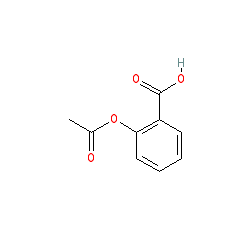GtoPdb is requesting financial support from commercial users. Please see our sustainability page for more information.
|
Synonyms: Acetophen® | acetylsalicylic acid | Aspirin®
aspirin is an approved drug (FDA (no history prior to 1965))
Compound class:
Synthetic organic
Comment: Aspirin is the prototypical cyclooxygenase inhibitor and inhibits the biosynthesis of prostaglandins. Aspirin acid also inhibits platelet aggregation and is used in the prevention of arterial and venous thrombosis.
Ligand Activity Visualisation ChartsThese are box plot that provide a unique visualisation, summarising all the activity data for a ligand taken from ChEMBL and GtoPdb across multiple targets and species. Click on a plot to see the median, interquartile range, low and high data points. A value of zero indicates that no data are available. A separate chart is created for each target, and where possible the algorithm tries to merge ChEMBL and GtoPdb targets by matching them on name and UniProt accession, for each available species. However, please note that inconsistency in naming of targets may lead to data for the same target being reported across multiple charts. ✖
View more information in the IUPHAR Pharmacology Education Project: aspirin |
|
|||||||||||||||||||||||||||||||||||
| No information available. |
Summary of Clinical Use  |
| Aspirin is used to treat pain, and reduce fever or inflammation. It is also used as a preventative treatment for heart attacks, strokes, and chest pain (angina). |









